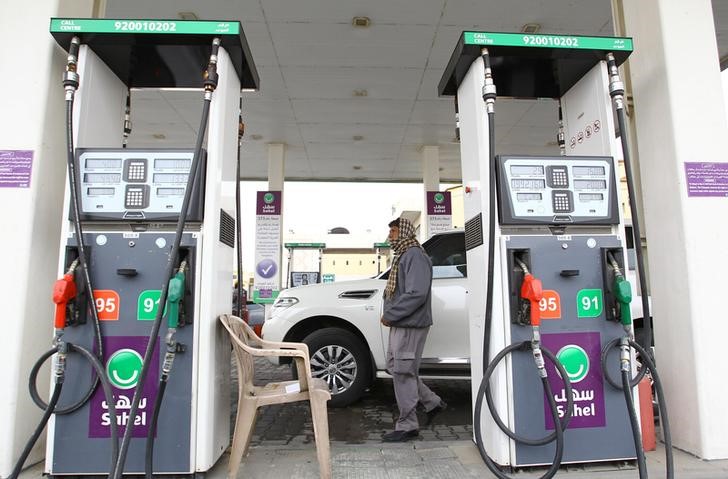 © Reuters. Worker walks at a petrol station in Riyadh
© Reuters. Worker walks at a petrol station in RiyadhBy Alex Lawler
LONDON (Reuters) – OPEC oil output fell in November by 300,000 barrels per day (bpd) to its lowest since May, a Reuters survey found, pressured by a drop in Angolan and Iraqi exports, strong compliance with a supply cut deal and involunary declines.
OPEC’s adherence to pledged supply curbs rose to 112 percent from October’s 92 percent, the survey found. Top exporter Saudi Arabia pumped below its OPEC target, as did all other members except Ecuador, Gabon and the United Arab Emirates.
The Organization of the Petroleum Exporting Countries is reducing output by about 1.2 million bpd as part of a deal with Russia and other non-member producers, which have also committed to production cuts.
Oil () is trading near a two-year high supported by falling inventories, strong demand and high compliance with the promised curbs. The producers at a Nov. 30 meeting extended the deal until the end of 2018, as expected.
“Based on the recent past we can start the New Year with relative optimism as far as conformity is concerned,” said Tamas Varga of oil broker PVM. “The outcome of last Thursday’s meeting looks constructive.”
The biggest drop in output in November, of 100,000 bpd, came from Angola where exports fell to a 13-month low. Angolan exports have been curbed in recent months by field maintenance.
The second-largest came from Iraq. Output and exports in northern Iraq fell in mid-October when Iraqi forces retook control of oilfields from Kurdish fighters who had been there since 2014, and declined further last month.
A boost in exports from Iraq’s south, the outlet for most of the country’s crude, to 3.50 million bpd in November has not quite offset the decline from the north, the survey found.
The decline means Iraq, a laggard on compliance compared to OPEC peers like Saudi Arabia earlier this year, has delivered its highest adherence yet, according to Reuters surveys.
Production in Venezuela, where the oil industry is starved of funds due to the country’s economic depression, declined further below its OPEC target, the survey found. Both exports and refinery operations were lower in November.
Algerian output declined for a second month because of planned oilfield maintenance.
Nigeria and Libya, the two producers exempt from the cut whose extra barrels helped OPEC output reach a 2017 high in July, both pumped less in November according to the survey.
Nigerian output slipped by 40,000 bpd. The country’s largest crude stream, Qua Iboe, was scheduled in November to export five cargoes, as much as half the rate normally seen.
Libyan output slipped by 30,000 bpd as protests impacted output at a Wintershall field. Libyan production remains volatile and, on average, below levels seen earlier this year.
OPEC agreed to cap Nigerian and Libyan output for 2018 at last week’s meeting.
Saudi Arabia trimmed output by 30,000 bpd, according to sources in the survey, further below its OPEC target.
OPEC last year announced a production target of 32.50 million bpd. The target includes Indonesia, which has since left OPEC, and does not include Equatorial Guinea, the latest country to join.
According to the survey, output in November has averaged 32.35 million bpd, about 600,000 bpd above the target adjusted to remove Indonesia and not including Equatorial Guinea.
With Equatorial Guinea, OPEC production in November totaled 32.48 million bpd, down 300,000 bpd from October and the lowest since 32.44 million bpd in May according to Reuters surveys.
The Reuters survey is based on shipping data provided by external sources, Thomson Reuters flows data, and information provided by sources at oil companies, OPEC and consulting firms.
Source: Investing.com

























